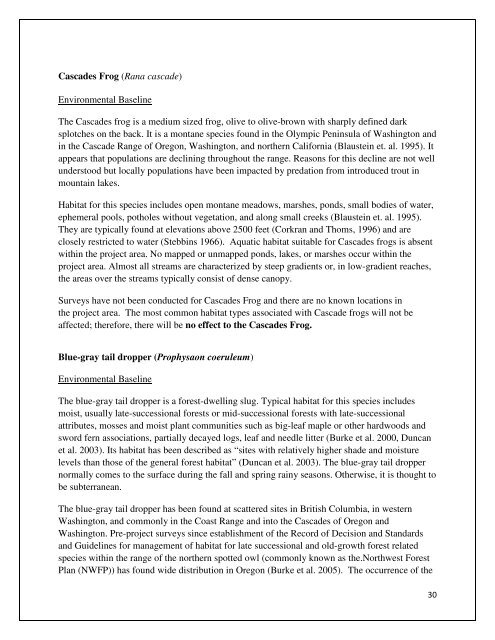Johnny O'Neil Late Successional Reserve Habitat Restoration and ...
Johnny O'Neil Late Successional Reserve Habitat Restoration and ...
Johnny O'Neil Late Successional Reserve Habitat Restoration and ...
You also want an ePaper? Increase the reach of your titles
YUMPU automatically turns print PDFs into web optimized ePapers that Google loves.
Cascades Frog (Rana cascade)<br />
Environmental Baseline<br />
The Cascades frog is a medium sized frog, olive to olive-brown with sharply defined dark<br />
splotches on the back. It is a montane species found in the Olympic Peninsula of Washington <strong>and</strong><br />
in the Cascade Range of Oregon, Washington, <strong>and</strong> northern California (Blaustein et. al. 1995). It<br />
appears that populations are declining throughout the range. Reasons for this decline are not well<br />
understood but locally populations have been impacted by predation from introduced trout in<br />
mountain lakes.<br />
<strong>Habitat</strong> for this species includes open montane meadows, marshes, ponds, small bodies of water,<br />
ephemeral pools, potholes without vegetation, <strong>and</strong> along small creeks (Blaustein et. al. 1995).<br />
They are typically found at elevations above 2500 feet (Corkran <strong>and</strong> Thoms, 1996) <strong>and</strong> are<br />
closely restricted to water (Stebbins 1966). Aquatic habitat suitable for Cascades frogs is absent<br />
within the project area. No mapped or unmapped ponds, lakes, or marshes occur within the<br />
project area. Almost all streams are characterized by steep gradients or, in low-gradient reaches,<br />
the areas over the streams typically consist of dense canopy.<br />
Surveys have not been conducted for Cascades Frog <strong>and</strong> there are no known locations in<br />
the project area. The most common habitat types associated with Cascade frogs will not be<br />
affected; therefore, there will be no effect to the Cascades Frog.<br />
Blue-gray tail dropper (Prophysaon coeruleum)<br />
Environmental Baseline<br />
The blue-gray tail dropper is a forest-dwelling slug. Typical habitat for this species includes<br />
moist, usually late-successional forests or mid-successional forests with late-successional<br />
attributes, mosses <strong>and</strong> moist plant communities such as big-leaf maple or other hardwoods <strong>and</strong><br />
sword fern associations, partially decayed logs, leaf <strong>and</strong> needle litter (Burke et al. 2000, Duncan<br />
et al. 2003). Its habitat has been described as “sites with relatively higher shade <strong>and</strong> moisture<br />
levels than those of the general forest habitat” (Duncan et al. 2003). The blue-gray tail dropper<br />
normally comes to the surface during the fall <strong>and</strong> spring rainy seasons. Otherwise, it is thought to<br />
be subterranean.<br />
The blue-gray tail dropper has been found at scattered sites in British Columbia, in western<br />
Washington, <strong>and</strong> commonly in the Coast Range <strong>and</strong> into the Cascades of Oregon <strong>and</strong><br />
Washington. Pre-project surveys since establishment of the Record of Decision <strong>and</strong> St<strong>and</strong>ards<br />
<strong>and</strong> Guidelines for management of habitat for late successional <strong>and</strong> old-growth forest related<br />
species within the range of the northern spotted owl (commonly known as the.Northwest Forest<br />
Plan (NWFP)) has found wide distribution in Oregon (Burke et al. 2005). The occurrence of the<br />
30
















